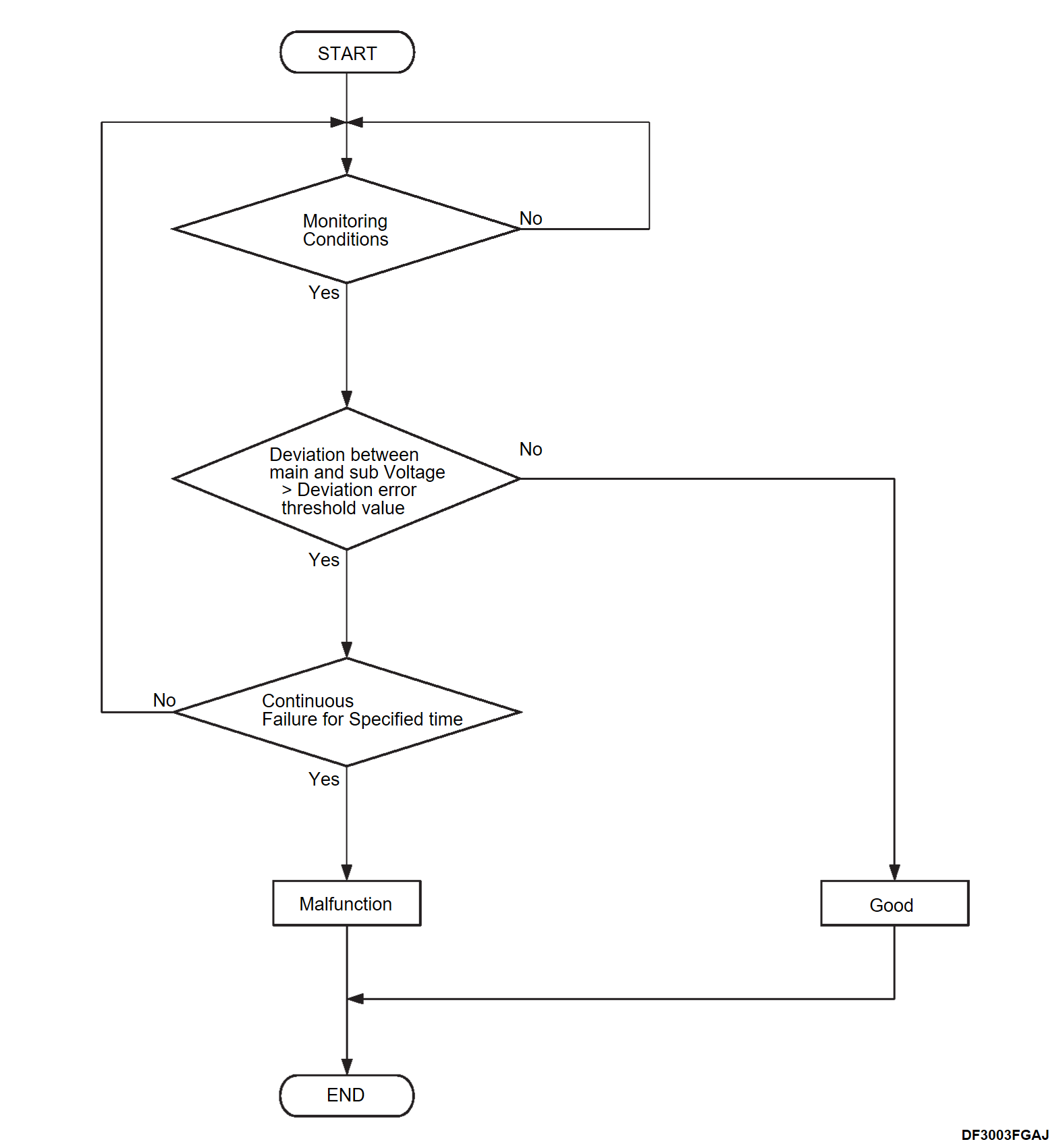DTC No. P2138-00 Accelerator Pedal Position Sensor "1"/"2" Voltage Correlation
MONITOR EXECUTION
Continuous
MONITOR EXECUTION CONDITIONS (Other monitor and Sensor)
Other Monitor (There is no temporary DTC set in memory for the item monitored below)
- Not applicable
Sensor (The sensor below is determined to be normal)
- Not applicable
Check Condition A
- The PHEV-ECU power supply voltage is 9.0 volts or more.
- EV power source relay drive signal is ON
- The accelerator pedal position sensor (APPS) (main) voltage is between 0.3 volt and 4.82 volts.
- The accelerator pedal position sensor (APPS) (sub) voltage is between 0.15 volt and 2.41 volts.
Check Condition B
- The PHEV-ECU power supply voltage is 9.0 volts or more.
- The power supply mode of the electric motor switch is ON.
- The accelerator pedal position sensor (APPS) (main) voltage is between 0.3 volt and 4.82 volts.
- The accelerator pedal position sensor (APPS) (sub) voltage is between 0.15 volt and 2.41 volts.
Judgment Criterion A
- The voltage deviation between the accelerator pedal position sensor (APPS) (main) and accelerator pedal position sensor (APPS) (sub) is more than the deviation error threshold voltage for 0.5 second or more.
Judgment Criterion B
- The voltage deviation between the accelerator pedal position sensor (APPS) (main) and accelerator pedal position sensor (APPS) (sub) is more than the deviation error threshold voltage for 0.2 second or more.
OBD-II DRIVE CYCLE PATTERN
- Refer to OBD-II Drive Cycle OBD-II DRIVE CYCLE
 .
.
TROUBLESHOOTING HINTS
- Damaged wiring harness and connectors
- Malfunction of the accelerator pedal (accelerator pedal position sensors 1 and 2)
- Malfunction of the PHEV-ECU
DIAGNOSIS
Required Special Tools:
- MB992744: Vehicle communication interface-Lite (V.C.I.-Lite)
- MB992745: V.C.I.-Lite main harness A
- MB992747: V.C.I.-Lite USB cable short
- MB992748: V.C.I.-Lite USB cable long
- MB991223: Wiring harness set
- MB992006: Extra fine probe
1.Check of short to ground circuit and open circuit in accelerator pedal position sensor 1 system line between PHEV-ECU and accelerator pedal
(1) Check the following lines for short to ground circuit.
- APV1line
- APS1line
(2) Check the following lines for open circuit.
- APV1line
- APS1line
- APG1line
Is the check result normal?
2.Check of short to ground circuit and open circuit in accelerator pedal position sensor 2 system line between PHEV-ECU and accelerator pedal
(1) Check the following lines for short to ground circuit.
- APV2line
- APS2line
(2) Check the following lines for open circuit.
- APV2line
- APS2line
- APG2line
Is the check result normal?
3.Test the OBD-II drive cycle.
(1) Carry out a test drive with the drive cycle pattern. Refer to OBD-II Drive Cycle OBD-II DRIVE CYCLE .
.
 .
.(2) Check the DTC.
Is the DTC set?
 Replace the accelerator pedal (Refer to Engine Control - Accelerator Pedal ACCELERATOR PEDAL REMOVAL AND INSTALLATION
Replace the accelerator pedal (Refer to Engine Control - Accelerator Pedal ACCELERATOR PEDAL REMOVAL AND INSTALLATION ), Then go to
), Then go to  .
. The trouble can be an intermittent malfunction (Refer to General Information - How to Use Troubleshooting/Inspection Service Points, How to Cope with Intermittent Malfunctions HOW TO COPE WITH INTERMITTENT MALFUNCTIONS
The trouble can be an intermittent malfunction (Refer to General Information - How to Use Troubleshooting/Inspection Service Points, How to Cope with Intermittent Malfunctions HOW TO COPE WITH INTERMITTENT MALFUNCTIONS ).
).4.Test the OBD-II drive cycle.
(1) Carry out a test drive with the drive cycle pattern. Refer to OBD-II Drive Cycle OBD-II DRIVE CYCLE .
.
 .
.(2) Check the DTC.
Is the DTC set?
 Replace the PHEV-ECU (Refer to PHEV-ECU REMOVAL AND INSTALLATION
Replace the PHEV-ECU (Refer to PHEV-ECU REMOVAL AND INSTALLATION ). Then,
). Then, 
 The procedure is complete.
The procedure is complete.5.Test the OBD-II drive cycle.
(1) Carry out a test drive with the drive cycle pattern. Refer to OBD-II Drive Cycle OBD-II DRIVE CYCLE .
.
 .
.(2) Check the DTC.
Is the DTC set?
 Retry the troubleshooting.
Retry the troubleshooting. The procedure is complete.
The procedure is complete.![[Previous]](../../../buttons/fprev.png)
![[Next]](../../../buttons/fnext.png)
